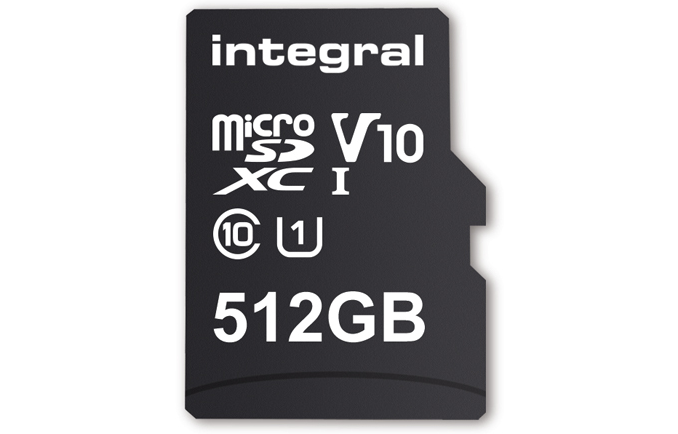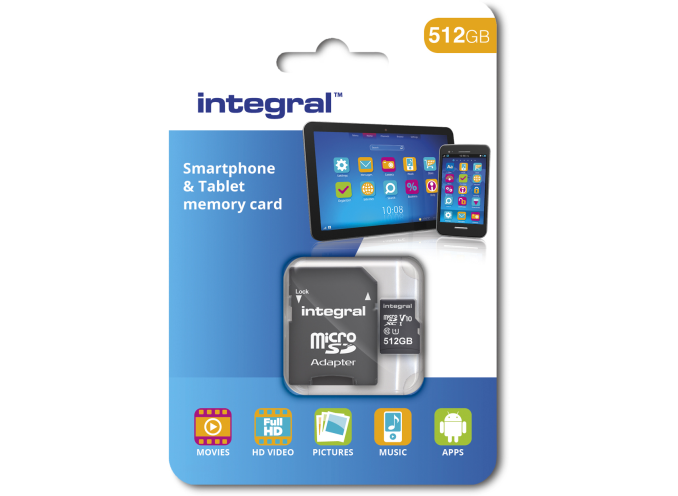Integral Launches 512 GB microSDXC Card: UHC-I, U1, Class 10
by Anton Shilov on January 25, 2018 1:30 PM EST
Integral Memory has released the industry’s highest-capacity microSDXC memory card that one can buy today. Integral’s new 512 GB microSDXC V10, UHS-I U1 card can store half of a terabyte of data, but its performance is not very high, meeting only the V10 specification for sequential write speed, limiting the recording of 4K video.
Integral’s 512 GB microSDXC card belongs to the company’s Class 10 UHS-I U1 lineup that already includes various capacities from 8 GB to 256 GB. These cards are aimed at Google Android-based smartphones, as well as tablets, and are designed primarily to store videos and images. The 512 GB microSDXC card uses the UHS-I bus and delivers up to 80 MB/s data transfer rate. The card also carries the Class 10 and UHS Speed Class U1 labels which guarantee that it supports at least 10 MB/s minimum sequential writing speed, which is enough for taking pictures and FHD videos. Meanwhile the card does not support any Application Performance Classes and therefore might not be suitable for huge mobile games or VR applications.
A number of manufacturers demonstrated microSD cards featuring 512 GB and even 1 TB capacities (some are even listed), but none of them has started commercial shipments of such products. The highest-capacity microSD card available today is the SanDisk Ultra Plus 400 GB that can be used to store applications.
| Integral 512 GB microSD Card at a Glance | |||
| General Specifications | |||
| Usable Capacity | ~512 GB | ||
| Read Speed | up to 80 MB/s | ||
| Write Speed | |||
| Minimum Sequential Write Speed | 10 MB/s | ||
| Operating Temperatures | 32ºF to 140ºF (0ºC to 60C) | ||
| Interface | UHS-I | ||
| Availability | February 2018 | ||
| SDA Labels | UHS-I, Class 10, U1 | ||
Integral plans to start selling its 512 GB microSDXC V10, UHS-I U1 card sometimes in February, but says nothing about its price. Typically Integral’s microSD cards for smartphones are shipped with a USB OTG (On-The-Go) microSDHC/XC card reader featuring dual USB connectors, but it looks like in case of the 512 GB microSDXC card the company will only supply a microSD-to-SD adapter.
For xkcd fans, this means that with microSD cards we can now reach 12.8 PB per gallon.
Related Reading
- Western Digital Launches SanDisk Ultra microSD Card with 400 GB Capacity
- SanDisk Launches Extreme PRO SD Cards: Up to 512GB
- ADATA Demonstrates 256 GB microSDXC Card
- Sony Announces SF-G UHS-II SD Cards: Up to Nearly 300 MB/s Read/Write Performance
- ADATA Demos A2-class microSD Card with 4K/2K IOPS Minimum, Mulls Late 2017 Launch
- ADATA Launches Premier ONE UHS-II SD Cards: 3D MLC, Up to 290 MB/s, V90 Labels
Source: Integral











22 Comments
View All Comments
mr_tawan - Monday, January 29, 2018 - link
Not everyone has unlimited internet access all the time. Always streaming is not an option for many people. Content playback does not require high-speed transfer rate (although content creation does.).damianrobertjones - Thursday, February 1, 2018 - link
So... I'll ignore this as I'd need one for a Surface Book. Oh well... shame that MARKETING dictates what's used for what. Sale lost. :)serendip - Friday, January 26, 2018 - link
I hope longevity isn't an issue, especially when used in smartphones where high temperatures are common. I've had Sandisk 128 GB cards fail just outside of warranty, it's a pain when one card holds so much data. A failed 512 GB card would be a nightmare both for data retrieval and for reloading on to another card.PeachNCream - Friday, January 26, 2018 - link
Oh gosh, I've had two Silicon Power microSD cards, a 64 and a 128GB fail in the past couple of years. I started buying Samsung EVO cards and I have a couple of 128GB in a phone and tablet plus a 32GB one in my Raspberry Pi. They've been okay so far, but none of them are more than 8 months old. The failures have taught me to be a lot more aware of making regular backups and storing data in more than one place. I haven't owned a Sandisk card larger than 32GB, but all of the ones I have laying around are still working very well. Maybe it's their larger capacity models that have problems.serendip - Sunday, January 28, 2018 - link
I've had 64 GB Sandisk and Kingston cards fail after two years and these were genuine units bought from reputable retailers. I've also had 128 GB Sandisk cards fail at just over a year. My 64 GB and 32 GB Samsung Evo cards have lasted 1.5 years, hopefully they'll last a bit longer.The best practice when using flash memory is to make frequent backups. These things aren't like HDDs, they're fickle and can fail when you least expect them to.
letmepicyou - Friday, February 2, 2018 - link
Yeah, I have a 64gb Sandisk SD in my Canon T5i that was giving me the "constantly flashing read/write light" thing, indicating a potential problem with my SD card. Luckily, I was able to pull the 40+ gb off the card and get it onto my desktop to be burned to disk...then low-level formatted the card in the camera (to hopefully write around bad blocks)...lord knows tho if it's on it's last legs or not, tho...Xajel - Saturday, January 27, 2018 - link
Isn't Sandisk offers lifetime warranty ?serendip - Sunday, January 28, 2018 - link
Yes, they do, but I'm more concerned about the data on the card. Failed Sandisk cards go into read-only mode, so if the card is used for private data then it's better to forgo the warranty and burn the damn thing.willis936 - Tuesday, January 30, 2018 - link
Your mistake is ever trusting cheap flash storage. If it isn’t a disc with magnetic information on it or flash with a controller don’t expect any data to be on it tomorrow. Only use it for transferring of files. In the case of phones keep things you care about like in app data and photos synced to a cloud service. If you care about your data existing that is.sna1970 - Friday, January 26, 2018 - link
10MB/s write speed is very low for such capacity.no thanks.